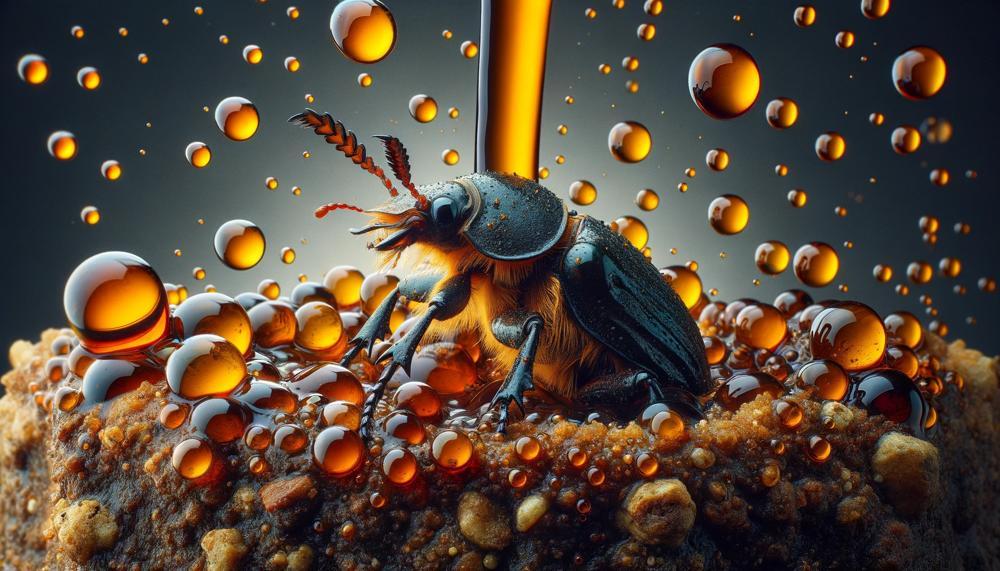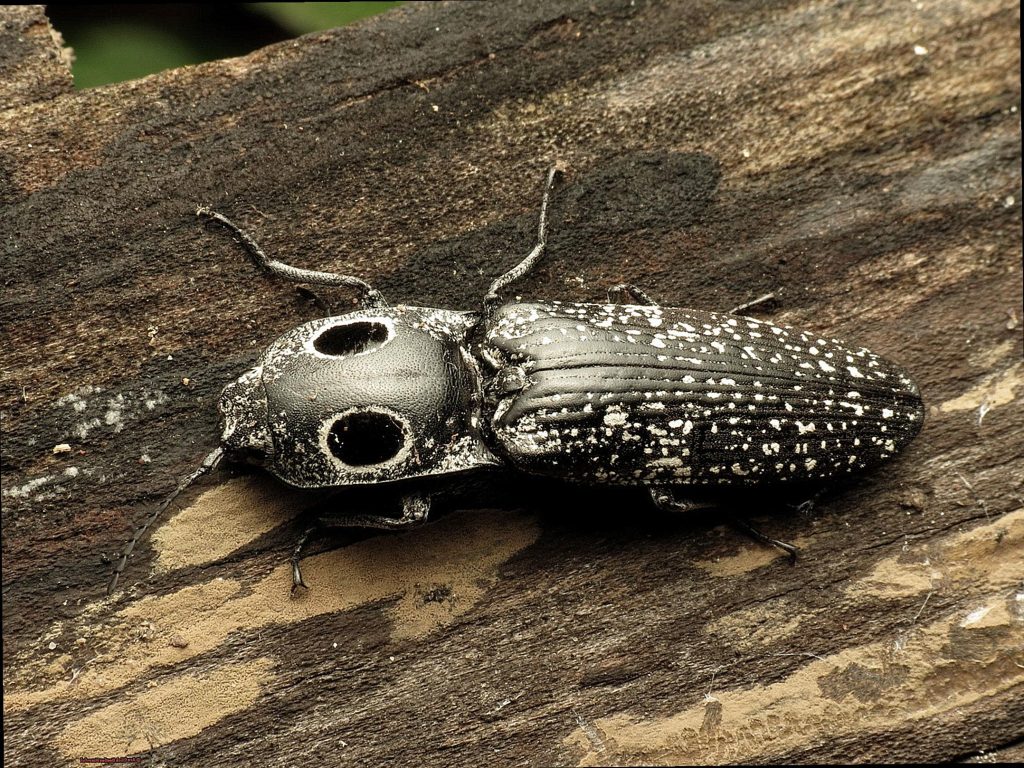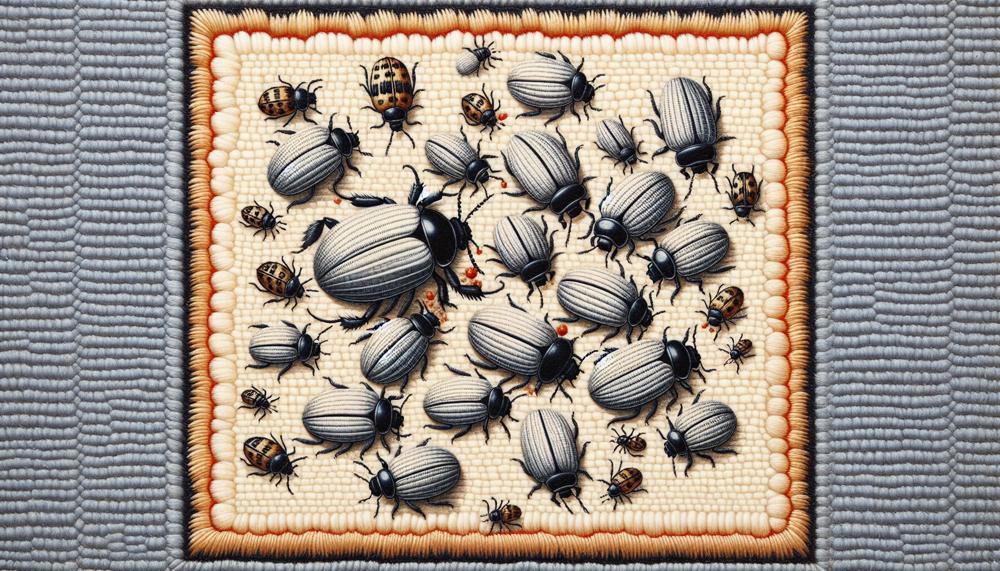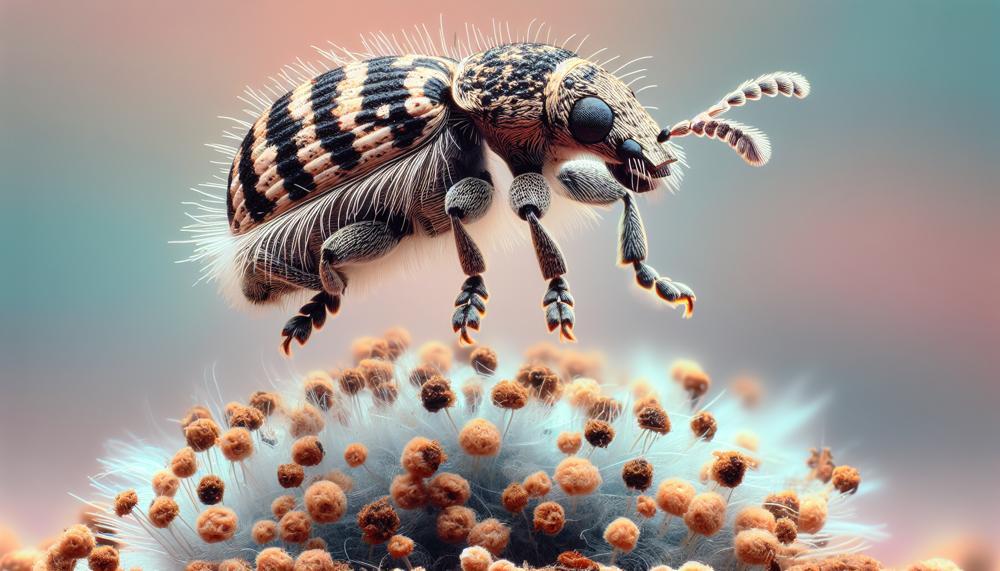As gardeners and homeowners, we often find ourselves in a quiet battle with nature’s less welcome visitors. Among these, ground beetles, with their glossy carapaces and nocturnal habits, can be both a friend to the garden and, at times, a considerable nuisance.
While they’re known for preying on harmful pests, an overabundance of these crawlers can lead to a different set of challenges.
If you’re seeking harmony in your garden without resorting to harsh chemicals, you’ve come to the right place.
In this comprehensive guide, we’ll explore effective, nature-friendly strategies to manage ground beetles and maintain the delicate ecological balance in your outdoor spaces. Here’s what we’ll cover:
- Understanding Ground Beetles: Get to know these insects and why they might be flocking to your garden.
- Preventive Measures: Simple adjustments to your garden care that can naturally deter ground beetles.
- Natural Repellents: Discover the substances and plants that can keep these beetles at bay, without harming the environment.
- DIY Traps: Step-by-step instructions for creating non-toxic traps to catch and relocate ground beetles.
Join me as we delve into the world of ground beetles and learn how to coexist with these creatures through methods that are kind to both our six-legged friends and Mother Earth.
Table of Contents
- 1 How To Get Rid Of Ground Beetles Naturally?
- 2 Identifying the Source of Ground Beetle Infestations
- 3 Introducing Natural Predators to Control Ground Beetle Populations
- 4 Using Plants as Natural Repellents for Ground Beetles
- 5 Maintaining Good Garden Hygiene to Prevent Infestations
- 6 Using Diatomaceous Earth to Dehydrate and Kill Ground Beetles
- 7 Creating a Homemade Insecticide to Target Ground Beetles
- 8 Conclusion
How To Get Rid Of Ground Beetles Naturally?
Tackling a ground beetle invasion doesn’t have to be a herculean task. With a few smart, natural strategies, you can bid farewell to these uninvited guests.
Eliminating Food Sources
Clear your garden of pests like slugs, snails, and caterpillars, which are a feast for ground beetles.
This can be achieved using diatomaceous earth or neem oil, nature’s own pest repellents.
Fortifying Your Fortress
Make your home a fortress against these critters by sealing entry points.
A dollop of caulk can seal their fate, keeping your living space beetle-free.
Natural Repellents
Nature’s own scents can send ground beetles packing.
Think of it as an olfactory ‘Keep Out’ sign, with mint, citrus, and lavender being the scents of choice.
Crafty Trapping
Outwit ground beetles with a trap that’s simplicity itself. A container with soapy water is like a siren’s call they can’t resist, leading them to a slippery demise.
Predator Party
Roll out the welcome mat for birds and frogs; they’re the unsung heroes in this tale.
A bird feeder or a pond can turn your garden into a hub for these natural beetle battlers.
Spick and Span
A tidy house is a beetle-free house. Regular hoovering and the banishment of clutter create a space that’s not just clean, but ground beetle-proof.
Identifying the Source of Ground Beetle Infestations
Ground beetles, mainly nocturnal critters, often sneak into homes, leaving owners befuddled. Let’s shed light on their common haunts and how you can spot them.
Common Infestation Sources
- Outdoor Lights: These beetles are like moths to a flame with lights. They’ll loiter around them at night.
- Under Rocks and Logs: By day, they’re undercover agents, lurking beneath rocks or logs.
- Gardens and Fields: Beetles have a field day in the garden, chomping on pests.
- Cracks and Gaps: Small openings are an open invitation for these insects to shuffle into your home.
Spotting the Culprits
| Location | Signs of Beetles | Action |
| Basements and Dark Corners | Dead beetles or live ones scurrying for cover | Declutter and light up these spaces |
| Entry Points | Beetles near doors or windows | Seal up any cracks and crevices |
| Outdoor Lighting | Beetles crowded around lights | Switch to motion-activated lights |
| Gardens | Plant damage or beetles on the prowl at night | Maintain cleanliness, remove plant debris |
Remember, these insects can’t breed indoors, so finding them inside means they’ve trekked in from the outdoors.
Keep an eagle eye out for them after dark, and you’ll be well on your way to sending these armored interlopers packing.
Eliminating the Problem
Cut down on their hangouts by tidying up the yard, chucking out that heap of leaves, and saying ta-ra to piles of wood. Got gaps? Seal them tight. And if you’re a fan of twilight ambiance, consider dimming those outdoor lights.
By following these tips, you’ll make your home as uninviting as a cold cuppa to these beetles. Keep your eyes peeled for their hideouts and block their entry with the zest of a spring clean.
Introducing Natural Predators to Control Ground Beetle Populations
To tackle the issue of ground beetles in your home, let’s look at some formidable natural predators that can keep their numbers in check:
| Predator | Type | Prey |
| Ladybugs (Coccinellidae) | Predator | Aphids, Scale Insects, Mites |
| Assassin Bugs (Reduviidae) | Predator | Various Insects |
| Lacewings (Chrysopidae) | Predator | Aphids, Caterpillars, Mealybugs |
| Ichneumonid Wasps (Ichneumonidae) | Parasitoid | Larvae of Beetles |
| Braconid Wasps (Braconidae) | Parasitoid | Caterpillars, Beetle Larvae |
| Tachinid Flies (Tachinidae) | Parasitoid | Caterpillars, Beetles |
| Sphecid/Crabronid Wasps (Sphecidae/Crabronidae) | Parasitoid | Various Insects |
Ladybugs are not just a treat for the eyes; they’re voracious predators of pesky insects like aphids. Assassin bugs, with their sharp beaks, take down a variety of insects with ease. Lacewings, with their delicate wings, might look dainty, but their larvae have a hearty appetite for soft-bodied pests.
Then we have the parasitoids, the stealthy operatives of the insect world. Ichneumonid and braconid wasps are like the special forces, targeting the larvae of beetles and other insects, laying their eggs inside or on them. The tachinid flies are similar, depositing their eggs on or in pests, leading to an internal takeover.
Incorporating these natural predators into your garden can significantly reduce ground beetle numbers.
Using Plants as Natural Repellents for Ground Beetles
Ground beetles can be a real bother when they decide to bunk in your home uninvited. But don’t fret, you can bid them goodbye with a few green allies from the plant kingdom.
Now, I’m not just spinning a yarn, these plants are the real McCoy when it comes to shooing away those beetles.
Marvellous Marigolds
Marigolds are not just a pretty face; their scent is like a boxer’s punch to ground beetles.
Plus, they’ve got this nifty compound, alpha-terthienyl, that’s like a secret weapon against these creepy crawlies. Here’s the lowdown on how effective they are:
| Plant | Repellent Compound | Effectiveness |
| Marigold | Alpha-terthienyl | Top-notch beetle buster |
Minty Fresh Defense
Next up, mint is more than a breath freshener; it’s like a bouncer at the door for ground beetles. Its strong scent masks the smell of your garden’s buffet, leaving those beetles with a rumbling tummy and no way to find the grub.
Herb Heroes
Rosemary, thyme, and lavender are not just your go-to for a fancy roast; they double up as a beetle barricade. They pack a scented punch that ground beetles can’t stomach.
Now, before you dash out to the garden centre, remember to pick plants that vibe with your local climate. Here’s a quick guide to help you out:
| Plant | Scent Strength | Best Location |
| Mint | Strong | Anywhere, really. It’s mint. |
| Rosemary | Robust | Sunny spots |
| Thyme | Bold | Well-drained soil |
| Lavender | Hearty | Full sun, good air circulation |
So, to keep those ground beetles at bay, plant these chaps around your home or garden, and you’ll have a natural barrier that’s both pleasant for you and unpleasant for the beetles.
Maintaining Good Garden Hygiene to Prevent Infestations
To prevent ground beetle infestations in a garden, there are several straightforward and nature-friendly strategies one can implement to maintain a healthy ecosystem without resorting to harsh chemicals. Here’s a breakdown of these methods:
Clearing Debris and Regulating Moisture
| Action | Benefit | Frequency |
| Remove garden debris | Eliminates beetle hiding spots | Daily or as needed |
| Mindful watering | Prevents overly moist soil | Water in the morning |
Also Read: # Companion Planting
| Plant | Repellent Properties | Placement |
| Catnip | Deters with strong scent | Around garden perimeter |
| Marigolds | Unpleasant to beetles | Intermixed with crops |
| Garlic and Chives | Beetles dislike the scent | Near beetle-favored plants |
Creating Barriers
| Barrier Type | Function | Application |
| Mulch | Blocks access to soil | Spread thinly around plants |
| Crushed eggshells | Sharp edges deter beetles | Circle the base of plants |
Encouraging Natural Predators
| Predator | Diet Includes Beetles | How to Attract |
| Centipedes | Yes | Provide ground cover and stones |
| Spiders | Yes | Avoid pesticides that harm them |
| Other Ground Beetles | Yes | Maintain a diverse garden |
To keep those shiny crawlers at bay, start by keeping your garden spick and span—think of it as a bit of housekeeping for your greenery. Boot out the clutter: piles of leaves, old pots, and the like, as they’re beetle magnets. And when you water, do it as the sun rises; it gives the earth a chance to dry up during the day, making it less inviting for the nocturnal ramblers.
Using Diatomaceous Earth to Dehydrate and Kill Ground Beetles
Diatomaceous Earth (DE) is a powerful ally in the fight against ground beetles, a common unwelcome guest in homes. Its effectiveness stems from its unique physical properties. Below, we dive into how DE tackles these critters.
The Mechanics Behind DE’s Efficacy
DE is composed of fossilized diatoms, which, under a microscope, reveal sharp edges. These edges are deadly to insects, such as ground beetles, for several reasons:
- Penetration of Exoskeleton: DE’s microscopic edges can pierce through the beetle’s protective exoskeleton.
- Absorption of Fats and Oils: It siphons off the oils and fats from the beetle’s cuticle.
- Dehydration: This leads to the loss of moisture, which is crucial for the beetle’s survival.
As the beetles traverse a DE-treated area, the particles cling to their bodies, initiating the dehydration process. This isn’t an instantaneous death; it’s a gradual decline as the beetle’s body dries out.
Application Tips for Optimal Results
For homeowners looking to employ DE, here’s how to maximize its beetle-busting potential:
| Location | Application Method | Expected Outcome |
| Doors and Windows | Apply a thin layer in thresholds | Prevents beetle entry |
| Outdoor Lights | Dust lightly around light fixtures | Reduces beetle attraction |
| Crevices and Cracks | Fill gaps with DE | Blocks beetle access points |
A Safer Choice for Your Home
DE is a friend to those seeking a non-toxic approach. It spares humans and pets from harm, targeting only the exoskeletons of insects. However, one should avoid breathing in the fine dust, so a mask is advisable during application.
Patience is Key

Remember, DE isn’t a quick fix; it’s a slow-acting solution. Ground beetles may take several days to succumb to dehydration. Regular reapplication may be necessary to maintain its effectiveness, especially after rain or cleaning.
Beyond Beetles
DE’s prowess isn’t limited to ground beetles. It assists in controlling a range of pests and even absorbs odours and moisture, contributing to a healthier, pest-free home environment.
In essence, DE combats ground beetles by sapping the life out of them, quite literally.
Creating a Homemade Insecticide to Target Ground Beetles
To combat the unwelcome ground beetle brigade, consider concocting a homemade insecticide using a variety of natural ingredients that pack a punch without the chemical fallout.
Below, find a table outlining the potent warriors in this battle, and remember, rotating your ammo will keep those beetles on their toes.
| Ingredient | Benefits | How It Works |
|---|---|---|
| Diatomaceous Earth | Non-toxic to pollinators; dehydrates beetles | Sharp edges pierce beetle exoskeletons, leading to dehydration |
| Garlic | Strong odour repels various pests | Crushed cloves in spray form deter beetles with its pungent scent |
| Neem Oil | Natural and biodegradable; disrupts insect life cycle | Interferes with feeding and larval development |
| Soapy Water | Readily available and easy to use | Clogs the beetles’ pores, suffocating them |
| Citrus Peels | Natural and fragrant | D-Limonene in citrus oil dissolves the beetles’ waxy coatings |
| Chili Pepper | Detracts a wide range of insects | Capsaicin repels beetles when sprayed on affected areas |
| Peppermint Oil | Strong scent disliked by many pests | Essential oil confuses beetles’ sensory receptors |
Garlic’s pungent aroma is quite the turn-off for ground beetles. Pair it with neem oil, a real bug-buster that messes with their appetites and growth. Don’t forget a dash of soapy water—it’s like kryptonite to beetle breathing pores. Add some zest with citrus peels; the limonene is like acid to their waxy coats. For a bit of heat, chili pepper is a fiery foe, while peppermint oil throws their senses into a tizzy.
Remember, it’s not about throwing everything but the kitchen sink at the problem.
Conclusion
After going over a variety of natural methods for dealing with ground beetles, it’s clear that a combination of proactive intervention, deterrent, and prevention is the key to living with these pests. Every move you take, from comprehending their habits to using predators and natural repellents, is a stitch in the fabric of a healthy ecology.
In conclusion, keep in mind that chemical warfare is not necessary to combat ground beetles. You can build a fortress that is naturally resistant to beetles by removing their food sources with neem oil or diatomaceous earth, sealing entry points to your home, using natural scents like mint, citrus, and lavender, making easy traps, allowing predator species to enter your garden, and keeping things clean. These techniques not only ward off insects but also foster a robust and healthy garden environment.
It is equally important to locate ground beetle aggregations and to restrict their entrances. De-light your outside lights to keep them from coming in, and clean up any trash in your yard to make them less likely to visit. To manage beetle populations, introduce natural predators such as parasitic wasps, ladybugs, and assassin bugs.
Finally, use plants that naturally repel pests, such as mint and marigolds, to protect your house with their strong fragrances. Managing ground beetles may be an organic and ecologically beneficial project if you follow this guidance.





